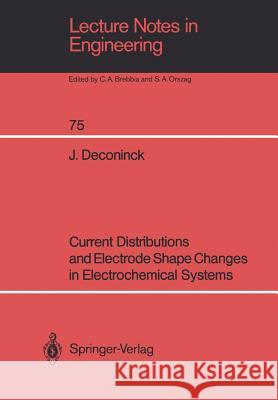Current Distributions and Electrode Shape Changes in Electrochemical Systems » książka



Current Distributions and Electrode Shape Changes in Electrochemical Systems
ISBN-13: 9783540551041 / Angielski / Miękka / 1992 / 281 str.
Current Distributions and Electrode Shape Changes in Electrochemical Systems
ISBN-13: 9783540551041 / Angielski / Miękka / 1992 / 281 str.
(netto: 384,26 VAT: 5%)
Najniższa cena z 30 dni: 385,52
ok. 22 dni roboczych
Bez gwarancji dostawy przed świętami
Darmowa dostawa!
A description of the computer modelling of electrochemical processes in order to improve their speed and efficiency. The text introduces the fundamental transport equations in dilute solutions and surveys the most important solution techniques, such as FEM, FDM and BEM.
1. The Current Distribution in Electro-Chemical Systems.- 1.1. Introduction.- 1.2. The electrode-electrolyte interphase.- 1.2.1. The equilibrium situation.- 1.2.2. Electrode reactions.- 1.2.3. The activation overpotential na.- 1.3. Transport equations in dilute solutions.- 1.3.1. The flux of a dissolved species.- 1.3.2. The current density.- 1.3.3. Conservation of mass.- 1.3.4. The Poisson equation or electroneutrality.- 1.3.5. The continuity equation.- 1.3.6. The Navier-Stokes equation.- 1.4. Solution of the transport equations in dilute solutions.- 1.4.1. Basic system of equations.- 1.4.2. The potential model.- 1.4.3. The concentration overpotential nc.- 1.5. The boundary conditions of the potential model.- 1.5.1. The boundary condition on-the walls.- 1.5.2. The boundary conditions on the electrodes.- 1.5.3. Additional boundary conditions.- 1.5.3.1. Resistive electrodes.- 1.5.3.2. Resistance involved by coatings.- 1.6. Types of current distributions.- 1.6.1. Introduction.- 1.6.2. The primary distribution.- 1.6.3. The secondary distribution.- 1.6.4. The tertiary distribution.- 1.6.4.1. Distribution over microprofiles.- 1.6.4.2. Distribution over macroprofiles.- 1.7. The Wagner number.- 1.8. Electrode shape change.- 1.8.1. Faraday’s law.- 1.8.2. The current efficiency.- 1.8.3. Moving boundaries and electrochemical machining 4.- 1.8.4. Equations to solve.- 1.8.5. Electrode shape change between parallel electrodes.- 1.8.6. Electrochemical machining between plane parallel electrodes.- 1.9. Conclusion.- 2. Solution of the Potential Model.- 2.1. Introduction.- 2.2. Hypotheses and definitions.- 2.3. Weighted residual statements for the Laplace equation.- 2.4. Solution of current distributions with trial functions satisfying the field equations.- 2.5. Solution of current distributions with trial functions not satisfying the field equations.- 2.5.1. The finite difference method.- 2.5.2. The finite element method.- 2.5.3. The Newton-Raphson iteration associated with the finite element method.- 2.5.4. The method of straight lines.- 2.6. Solution of current distributions based on weight functions satisfying the field equation.- 2.6.1. The boundary element method.- 2.6.2. The Newton-Raphson iteration process in boundary elements.- 2.7. The physical interpretation of the integral equation.- 2.7.1. The potential generated by a charged surface.- 2.7.2. The potential generated by a double source density on a surface.- 2.7.3. Green’s formula and source distributions.- 2.8. The outer normal convention..- 2.9. Indirect and regular boundary methods.- 2.10. Comparison of the treated weighted residual methods.- 2.11. Solution of current distributions by electric simulation.- 2.12. Conclusion.- 3. The Boundary Element Method to Solve Current Distributions.- 3.1. Introduction.- 3.2. Concretization of the boundary element method.- 3.2.1. Choice of used elements.- 3.2.1.1. Two-dimensional problems.- 3.2.1.2. Three-dimensional axisymmetric problems.- 3.2.2. Combination of regions.- 3.3. The overvoltage equations.- 3.3.1. The Butler-Volmer equation.- 3.3.2. The concentration overpotential.- 3.3.3. Linear and measured overpotentials.- 3.4. Solution of the non-linear system of equations.- 3.4.1. Solution of the linear system of equations 120 3.4-.2. Iteration techniques for non-linear systems.- 3.4.2.1. The successive substitution method.- 3.4.2.2. The Newton-Raphson iteration method - Global convergence conditions.- 3.4.2.3. Convergence criteria.- 3.4.2.4. A Newton-Raphson iteration versus a successive substitution.- 3.5. Examples.- 3.5.1. The Hull-cell.- 3.5.2. The influence of overpotentials on singularities.- 3.5.3. Industrial production-type cells.- 3.5.3.1. Two-dimensional cell composed of an electrode with open part and separator.- 3.5.3.2. A chlorine production cell.- 3.5.4. Current distribution in a circular hole.- 3.6. Copper electrorefining: numerical and experimental results.- 3.6.1. Electrochemical data 14..- 3.6.1.1. The electrolytic solution.- 3.6.1.2. The overvoltages.- 3.6.2. The cell geometry.- 3.6.3. The measuring equipment.- 3.6.4. The experimental procedure.- 3.6.5. Experimental results.- 3.6.5.1. Measurement 1: 6 cm interelectrode distance.- 3.6.5.2. Measurement 2: 12 cm interelectrode distance.- 3.6.6. Comparison with calculations.- 3.7. Conclusion.- 4. Electrode Shape Change.- 4.1. Introduction.- 4.2. The discretization with respect to time.- 4.2.1. The Euler method.- 4. 2.1.1. Convergence and accuracy.- 4.2.1.2. Stability.- 4.2.2. Higher-order integration schemes.- 4. 2.2.1. The predictor-corrector method (Heun).- 4.3. The electrode shape change algorithm.- 4.3.1. Electrodeposition.- 4. 3.1.1. Electrode next to an insulator: internal angle > ?/2.- 4.3.1.2. Electrode next to an insulator: internal angle ? ?/2.- 4.3.2. Electrode dissolution.- 4.3.3. Electrochemical machining.- 4.4. Examples.- 4.4.1. Electrodeposition in a Hull-cell.- 4.4.2. Deposition and dissolution in a cell with sinusoidal profile.- 4.4.3. Anodic leveling and electrochemical machining in a cell with irregular shape.- 4.4.4. ECM in a cell with hemispherical cathode.- 4.4.5. Conclusion: comments on the efficiency of the BEM.- 4.5. Electrodeposition and electrode dissolution in copper electrorefining. Numerical and experimental results.- 4.5.1. Electrochemical data.- 4.5.2. The cell geometry.- 4.5.3. The measuring equipment.- 4.5.4. The experimental procedure.- 4.5.5. Experimental results and comparison with calculations.- 4.5.6. The influence of a screen.- 4.6. Conclusion.- 5. General Conclusion.- References.- Appendices.- A.1.1 Primary current distribution along a free cathode in parallel with an anode and perpendicular to an insulating boundary.- A.1.2 Primary current distribution along an L-shaped cathode.- A.1.3 Primary current distribution along a cathode being in line with an insulating boundary.- A.2 Solution of the potential model using trial functions satisfying the field equation: example.- A.3.1 Analytic integration of integrals involved by the two-dimensional boundary element method using straight elements.- A.3.2 Evaluation of integrals involved by the boundary element method used to solve axisymmetric potential problems.- A.4 The global Newton convergence of the potential problem with non-linear boundary conditions.
1997-2025 DolnySlask.com Agencja Internetowa
KrainaKsiazek.PL - Księgarnia Internetowa









